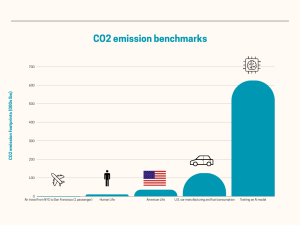Artificial intelligence (AI) is widely regarded as a revolutionary technology with the potential to transform industries. However, the environmental consequences of AI development, operation, and disposal are often overlooked. The carbon footprint generated by AI technologies, driven primarily by the massive energy demands needed to train complex models, is becoming a significant concern.
A recent study conducted by researchers at the University of Massachusetts found that training popular AI models can produce around 626,000 pounds of carbon dioxide, roughly equivalent to 300 round-trip flights between New York and San Francisco. This figure is nearly five times the lifetime emissions of the average car. The study highlights the stark contrast between AI’s carbon footprint and everyday activities like transportation, raising alarms over the sustainability of AI.
In addition to energy consumption, AI’s demand for technology is contributing to a surge in electronic waste. AI systems require more hardware—computers, servers, and other devices—to operate efficiently, leading to higher disposal rates at the end of their life cycles. This could result in more electronic waste than previous computer systems installed at business facilities, creating further environmental challenges.
AI’s environmental risks extend beyond energy use and electronic waste. Applications like autonomous vehicles and drones have the potential to disrupt ecosystems, while AI-driven agricultural systems could lead to overuse of pesticides and fertilizers, harming biodiversity. These impacts make it essential to consider the broader environmental consequences of AI deployment.
Professor Benjamin Lee of the University of Pennsylvania’s Environmental Innovations Initiative has been vocal about the high energy costs of generative AI models. “Generative AI models, like ChatGPT, are going to be much more computationally expensive than traditional data center jobs,” he said in a recent interview. Lee emphasized that asking AI-based systems for answers could consume seven to ten times more energy than a standard Google web search. As AI adoption increases, so will the demand for energy, which could exacerbate environmental issues if not addressed.
Despite these challenges, there are strategies for making AI more eco-friendly. Developing energy-efficient hardware and designing algorithms that minimize unnecessary data processing can significantly reduce energy consumption. Ethical AI design, which considers the entire lifecycle of AI technology—from production to disposal—also plays a critical role in reducing its environmental impact.
Transparency and accountability are key to mitigating AI’s environmental harm. AI developers should be required to share detailed information on how their models affect the environment, enabling stakeholders to make informed decisions. Governments and regulatory bodies must also step in to establish clear standards to ensure AI is created, used, and disposed of responsibly.
However, AI could also play a role in fighting climate change. Innovations like ‘WattTime’ and ‘Climate TRACE’ use AI to monitor emissions through satellite imagery, helping businesses and policymakers track pollution and reduce their carbon footprints. If the AI industry can find ways to reduce its environmental impact, AI technologies could become valuable tools in the global effort to combat climate change.
Professor Cary Coglianese, also of the University of Pennsylvania, weighed in on the discussion, stating, “Looking for more efficient sources of energy for manufacturing, production, and transportation is certainly an important area to explore. The main policy issue with AI today is how to manage the fast pace of innovation, especially in the private sector, while also protecting the public from some of the risks associated with artificial intelligence, such as privacy, bias, and manipulation.”
Balancing AI’s incredible potential with its environmental responsibilities requires collaboration among businesses, policymakers, and researchers. If managed carefully, AI could contribute to both technological innovation and sustainability, ensuring that progress does not come at the cost of the planet.
By fostering responsible AI development and adopting greener technologies, the world can harness the benefits of AI without compromising the environment for future generations.
Sources:
Kanungo, A. (2024, March 5). The real environmental impact of AI. Earth.Org. https://earth.org/the-green-dilemma-can-ai-fulfil-its-potential-without-harming-the-environment/
Coleman, J. (2024, February 20). Ai’s climate impact goes beyond its emissions. Scientific American. https://www.scientificamerican.com/article/ais-climate-impact-goes-beyond-its-emissions/
Safdie, S. (2024, May 31). What is the environmental impact of AI?. Greenly. https://greenly.earth/en-us/blog/ecology-news/what-is-the-environmental-impact-of-ai









